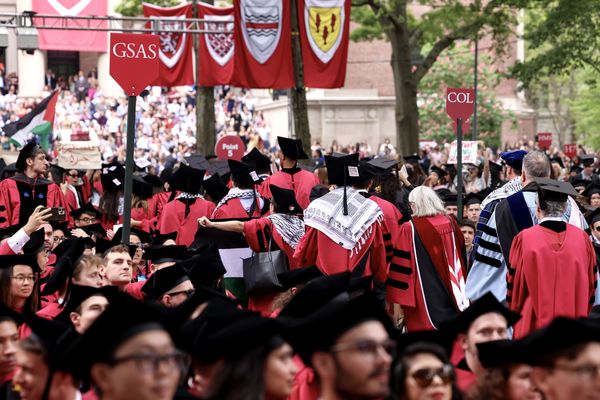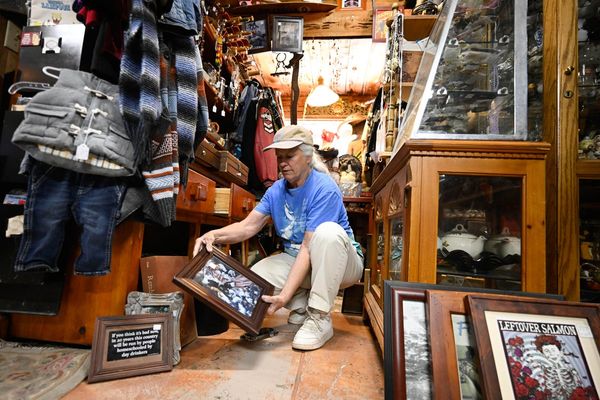
Soaring on monsoonal winds their arrival was an alarm.
For the Tiwi people the sight of the frigatebirds was the first sign a cyclone was brewing off the coast of Darwin in 1974, but no one predicted the scale of destruction that would hit that Christmas Day.
Cyclone Tracy displaced 36,000 people and officially claimed 66 lives, although others were lost in the aftermath of the devastation.
Museum Art Gallery Northern Territory history curator Jared Archibald said Cyclone Tracy "put Darwin on the map".
The curator of the revamped 'Remembering 50 years of Cyclone Tracy' said it was considered one of the most destructive cyclones in Australia's history, with wind gusts of 217km/h.
Three days after Christmas, Prime Minister Gough Whitlam returned from his 15-nations European trip to visit the NT capital, saying that coming "to the aid of Darwin was our greatest national challenge for nearly 30 years."
Mr Whitlam established the Darwin Reconstruction Commission which Mr Archibald said reminded Australians of the town's critical position.

"It put Darwin on the map for the wrong reasons, but it also showed how important Darwin was from a strategic point of view," he said.
"We're the only deep water port basically between Perth and Brisbane across a huge amount of northern coastline that faces into Asia."
Mr Archibald said people spoke about rebuilding the city somewhere else, however, it was Gough Whitlam who remained steadfast in retaining Darwin's coastal position.
"He just quashed it completely and said we will rebuild here," Mr Archibald said.
The tropical cyclone brewed in the Timor Sea for a number of days before crossing the coast near Fannie Bay at 3:30 on Christmas morning.

Like more than 50,000 others, Bruce and Jean McDougall weathered the cyclone in the smallest room in their home - the linen press.
"We sheltered in there, we put the kids on each shelf, and the dog, the cat, Bruce and I just sat at the bottom and put our head underneath a shelf," recalled Ms McDougall.
Emergency broadcast messages told people to get in the bath tub but Ms McDougall's instinct was to hide in the linen press which was completely wrapped around by the rest of the house.
"We were lucky, because everything else was just gone," she said, thinking back to the rubble that became her home.
"It was the only thing left standing."
Territory locals describe the cyclone as having a terrifying sound of corrugated iron sheets scraping across asphalt and smacking into people's homes as they tried to survive.
In those early hours on December 25, while in darkness surrounded by her children and pets, Ms McDougall recalled hearing the house fall down around her.
"We'd say, oh, that's the glass door. That's the window ... the next morning, we just wandered out but words can't describe what you saw."
She and her husband refused to evacuate after the cyclone, instead choosing to stay and assist with the clean-up. However, her three children were forced to Adelaide under government mandates and it would be weeks before she saw them again.
Ms McDougall said 50 years on that the enduring emotion is one of gratitude.
"I think we were just so grateful that we survived it."
Cyclone Tracy embroidered itself into the fabric of Darwin's culture, the impact of its aftermath stretching decades. While the cyclone grounded the McDougalls in Darwin for life, many other families never returned.
Mr Archibald said the aftershocks of the weather event continue to be felt within the community, and conjecture about the actual number of people killed is complicated.
He said its narrow definition excludes people who suicided or others who may have died from injuries at a later date.
One mother who was injured while cycling was evacuated to Sydney and died three weeks later," he said.
"That was a name we didn't know about.
"There's a lot of rules as to how people are included on lists with disasters and being three weeks later, but dying from her injuries, we've included her as a mention, but not in the official 66."

Those ongoing impacts have led to traditional owners opening up healing ceremonies for the community.
Larrakia traditional owner Christine Fejo-King was 20 when the cyclone ripped through and she remembers landing in Adelaide with only the clothes on her back.
"The people that met us were from the Red Cross and the Salvation Army. They were running up and trying to hug us, and we were running backwards," she said.
"It was kind of funny, because they were wanting to hug us, and in our culture, that just doesn't happen."
"But they were so kind to us."
Many people have never thought about how Cyclone Tracy was an "opportunity to repay" the traditional owners in Australia's north said Ms Fejo-King.
The cyclone was not the first time Darwin was devastated, just three decades earlier Japanese fighter jets dropped more than 680 bombs on the town during World War II.
The nation doesn't remember the story of Black Watch, says Ms Fejo-King, a militia group of Aboriginal men who fought to prevent the war from heading to southern states.
"They fought for everyone…it was for our country, yes, but (what they did) was also to keep Australia safe," she said.
Her family believe when Cyclone Tracy came it was a turning point in the nation's history. After decades of pillaging Country of its people Ms Fejo-King said the rest of Australia had a chance to embrace us.
"Everything was destroyed. It was a renewal of everything.

"The trees were gone, the animals were gone, the insects were gone, the people were gone … Country was left in stillness, and stillness is a time to heal."
Ms Fejo-King said everyone asks about the trauma of Tracy, but no one asks about the healing.
And while she is not immune to the devastation of the weather event, she believes it gave Country an opportunity to heal because it united people in humanity.
"I'm talking about Aboriginal and non-Aboriginal people - the whole country supporting us - and they were there for us," she said.
"And that, I think is what the real spirit of Australia is really all about."







